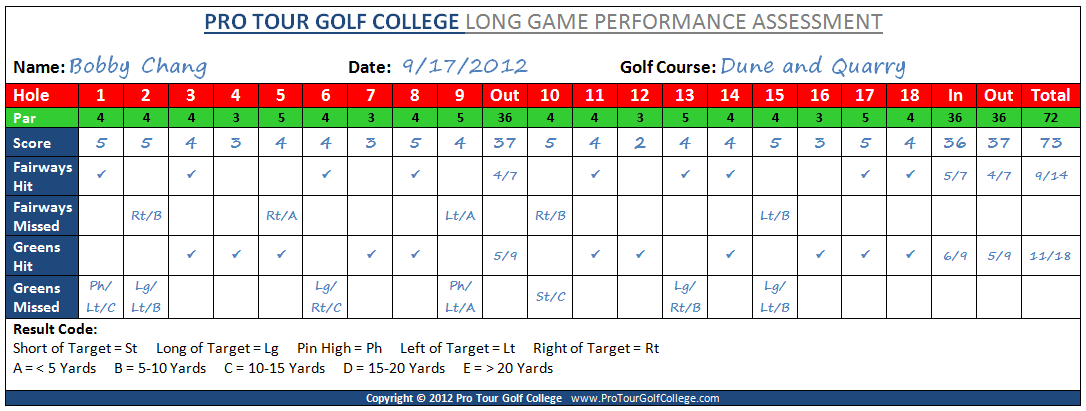 There seems to be three parts to golf improvement. The first part is the decision you make to get better. The second is to decide on the best strategy you will use for getting there; and the third part is the execution of your strategy. Simple enough right? Well, yes it’s simple in theory and simple enough if you know how to go about it, but for many golfers who want to improve their game it’s not that simple because they really don’t know how to go about it. The first part of game improvement is the assessment of your current position and golfers from novice to expert are notorious for guesstimating the current position of their game which makes it almost impossible to work out an effective strategy for improvement. For instance when asked for their current competitive score average or greens hit regulation statistic etc, the most common response of many elite golfers we have worked with is “it’s about...” Why do they guess where they’re at? If you want to become a top level amateur or professional golfer you have to move well beyond guessing where your game is at to have any chance of improvement.  If you want to lower your competitive score average you need to develop the habit of measuring your skills accurately to manage and improve your performances. Many motivated golfers will measure their performances on the golf course using very basic statistics such as green’s hit in regulation and fairways hit in regulation but this isn't good enough for developing really low golf scores. This is a good start but you have to move well beyond these basic statistics to continue to find useful strategies to lower your lowest golf scores. “Performance attribution analysis is difficult using the current standard golf statistics, many of which involve relatively crude counting measures.” – Mark Brodie What’s interesting is that this is not that difficult to do! If you really want to improve your skills and performances on the golf course then you really need to start tracking your effort more specifically. For example when you hit tee-shots on a golf course you can measure how many tee shots went into the fairway and how many didn't, and you can also measure how far off-line your tee shots went when they missed the fairway because it won’t help you to know that you hit 7 fairways out of 14, if 4 of the 7 tee-shots that missed the fairway missed it by more than 20 yards! This is a weakness of basic statistics that they don’t reveal this, and what this means for you is that this statistical approach is not as helpful to you if you want to lower your lowest golf score. You can see that using a simple assessment tool like the one above that you can more accurately measure your long game success on the golf course. Using a simple code like the one in the illustration you can accurately track the direction of your golf shots on the golf course so you can analyse your strengths and weaknesses and develop a strategy for improvement. In the 10 round analysis above you can clearly see that Bobby hit 112 tee shots over 8 rounds of golf and that he hit the fairway 63.4 percent of the time and 31.7 percent of his tee shots missed to the left of the fairway and 68.2 percent missed to the right. Not only that, we can measure how far the bad tee shots missed the fairway by which can help us to determine whether the problem is golf swing, mental or equipment.
This is extremely important information for the golfer and the golf instructor as it forms the foundation for developing an effective improvement strategy. Standard statistics don't reveal this type of information and you need it to make smart decisions about the direction of your golf development. By developing simple and accurate assessment tools like the ones we use at Pro Tour Golf College that dig deeper into the statistics of our students we can get to the root cause of problems in their game more effectively without the guess work. This means that we can help them to improve their lowest golf score and move them ever closer to living their dream of becoming a low score super competitive professional golfer. Lawrie Montague and David Milne - Pro Tour Golf College Your Success On Tour is Our Business Comments are closed.
|
Archives
June 2019
|
Proudly Supported By
Copyright © 2011 - 2018 Pro Tour Golf College
Website Managed By Golf Performance Media
All Rights Reserved
Website Managed By Golf Performance Media
All Rights Reserved



 RSS Feed
RSS Feed



